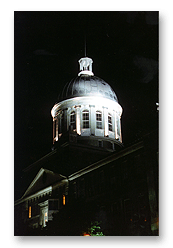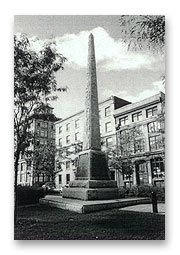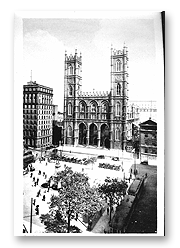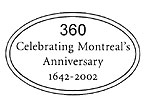
 |
Old Montreal - Place d’Youville Excerpt from Exploring Old Montreal: An Opinionated Guide to the Streets, Churches and Historic Landmarks of the Old City by Alan Hustak
Montreal became the capital of The United Province of Canada in 1844 and the government moved into St. Ann’s Market, an imposing two-storey limestone building that was built here in the early 1830s. The marketplace, 350 feet long and 50 feet wide, was converted into an imposing House of Assembly. The Legislative Council was in the east wing, the House of Assembly occupied the west wing. John A. Macdonald, later Canada’s first prime minister, made his maiden speech as a parliamentarian in the building on April 27, 1846. The first experiment in joint government between English and French, however, ended in disaster. Montreal might have remained the national capital to this day had a booze-soaked Anglo mob not torched the parliament building on April 25, 1849. Inflamed by incendiary editorials in The Gazette the crowd marched on the building to show its anger at legislation passed by the assembly which would have required the Crown to compensate French Canadians for damages caused by the British Army during the Rebellion of 1837. All that was saved from the fire was the legislative mace, and a portrait of Queen Victoria which now hangs in the lobby outside the Senate Chamber in Ottawa. As a result of the violence Montreal lost its status as capital of Canada, and the seat of government alternated between Quebec City and Toronto until 1858 when Queen Victoria settled on Ottawa as the capital. A second market—“a queer pagoda like building”—was built on the same site in 1851, expanded in 1871 and burned in 1893. The walls were demolished in 1901 and the square was named Place d’Youville in honour of St. Marguerite de Lajemmerais d’Youville (1701-1771), founder of the Sisters of Charity, commonly known as the Grey Nuns. She is the first Canadian-born saint, and was canonized by the Vatican in 1994. The huge neo-classical building with splendid arched doorways on the south side of the parking lot is the Canada Customs House (400 Place d’Youville), which was the setting for the heist in The Score, the recent movie starring Robert De Niro and Marlon Brando. The first three floors are faced in granite, and the floors above that, sandstone. It was built in stages by the Ministry of Public Works between 1912 and 1936. There is a vast and impressive central hall inside, as well as a small display on the history of Canada Customs.
Just beyond the ruins of the hospital’s old chapel is the Musée Marc-Aurèle Fortin (118 St. Pierre, 514-845-6108). Fortin (1888-1970) a prolific painter of robust Quebec landscapes and massive trees, painted about 10,000 works, most of which were destroyed or lost after he was hospitalized in 1967. Mistreated during his life-time, this museum dedicated to his paintings opened in 1984. The plaque at 224 St. Pierre marks the site of first Governor’s Mansion built by Louis Hector de Callières, (1648-1703 ) who was acting governor of New France from 1698 to 1703. Callières left his mark on history by making peace with the Iroquois in 1701. His mansion was built in 1688 and after the British conquest in 1760 fell into ruins and was left to deteriorate. The walls were torn at the beginning of the 19th century. At 298 St. Pierre you will find old warehouses that have been converted into upscale condos and office space. The courtyard, with its ivy covered walls is always inviting. The first door to the left as you walk through the gates is Gibby’s (514-282-1837), Montreal’s most popular steak house. It’s not the city’s best steak house but its stone walls, low ceilings, wood beams and fireplace project enough warmth and old world ambiance that the regulars keep coming back. Gibby’s has been around for 30 years, and word of mouth has made it one of those places you have try just to say you have been there. Reservations should be booked well in advance. The red brick building directly across the street from Gibby’s, on an island in the middle of Place d’Youville, is the the old Number One Fire Station. It was built in 1903 and in 1983 was converted into the Centre d’histoire de Montréal (335 Place d’Youville, 514-872-3207), a civic museum. The interior was completely refurbished in 2001 and the new exhibition space is filled with nostalgia. Typical daily life in a typical Montreal family in days gone by. You can hear snippets of Hockey Night in Canada broadcasts, listen to a recitation of the rosary, or take a simulated tram ride on an old Montreal street railway car. The main floor features an exhibit called five windows on history, and each of the five alcoves has a theme dealing with the development of Montreal. Among the treasure trove of civic memorabilia you can find the baseball bat used by Jackie Robinson when he played for the Montreal Royals in 1947 and the first contract Maurice ‘Rocket’ Richard signed in 1942 with the Montreal Canadiens for $5,000 a season. A small gallery on the third floor houses a circulating exhibition, and to get to it you have to go through a glassed in walkway on the roof that offers visitors yet another panoramic view of Old Montreal. Admission is $6.25 for adults, $5.50 for seniors and students. The area behind the Centre d’Histoire is known as Place de la Grand Paix, named in honour of the Great Peace of Montreal, a treaty signed on the same spot in 1701 between the French and 39 aboriginal nations.
The stylized playful and poetic metal cross immedi-ately behind the old fire hall is a sculpture by Gilles Mihalcean called “L’oeuvre.” It symbolizes the origins of the French-speaking Roman Catholic Church in America. It was installed in 1993. Look east and you will see a grey granite obelisk. It is dedicated to Montreal’s founders, the original 35 colonists who arrived from France in 1642. The obelisk is made from a block of granite that stands 41 feet tall and is three feet square at its base. It weights 22-tonnes, and is said to be the largest piece of stone ever quarried in Canada. It took 40 horses to drag the shaft into the city in 1893. The monument was erected in May, 1894, and has been moved a number of times before it was placed in its present location in 1999. Landscape architect Claude Cormier’s interpretive design for Place d’Youville is meant to suggest a quilt; a single whole stitched together from many many historic elements. The granite walkway through the centre makes reference to an underground stream, the Little St. Pierre River which was vaulted over in 1832. Wooden walk-ways cross from domestic door to domestic door and ankle high granite fencing and waist high lighting symbolize four centuries of movement through the square. Cormier has also a designed a treatment for the parking lot in the west section of Place d’Youville where the Parliament once stood, but it has not yet been adopted. © 2002, Alan Hustak |
|||||||||
|
| Downtown Montreal Guide | Old Montreal Guide | Guide to Eating Out | Walking Tours | | Urban Landscape | Guide to Literary Montreal | Montreal Vintage Photos | | Montreal Links | Montreal Jazz | www.vehiculepress.com © Véhicule Press, All Rights Reserved |



